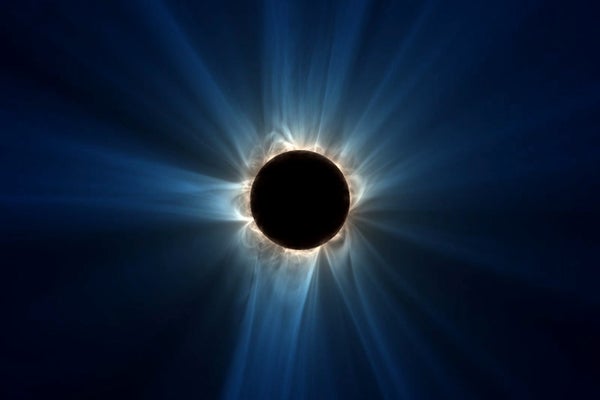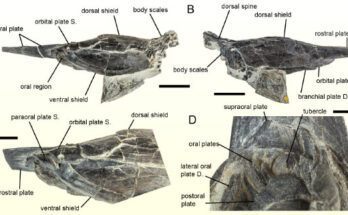Photo voltaic Eclipse Will Reveal Gorgeous Corona, Scientists Predict
Predicting what the solar will appear to be throughout a complete photo voltaic eclipse is a useful train for scientists within the lengthy quest to grasp how our star works

Predictive Science Inc.’s prediction one week upfront of what the solar’s magnetic discipline will appear to be on eclipse day, April 8, 2024.
This text is a part of a particular report on the whole photo voltaic eclipse that can be seen from components of the U.S., Mexico and Canada on April 8, 2024.
Photo voltaic eclipse chasers have good cause to hope for a very spectacular sight on April 8 when the moon briefly passes in entrance of the solar.
However not everyone seems to be content material to attend till the large second to see what the solar will appear to be. A group of scientists is utilizing supercomputers and extra-fresh knowledge to foretell the looks of the solar’s outer environment, or corona. The area is just obvious throughout a complete photo voltaic eclipse, when the moon exactly blocks out the sunshine from the solar’s seen floor, so the train permits scientists to check their understanding of how the solar’s magnetic discipline governs the star’s environment.
On supporting science journalism
When you’re having fun with this text, think about supporting our award-winning journalism by subscribing. By buying a subscription you’re serving to to make sure the way forward for impactful tales in regards to the discoveries and concepts shaping our world at present.
And today that magnetic discipline is tremendous lively, making it further tough for researchers to anticipate the view of the corona. “We knew going into this that the solar may be very dynamic now. It’s close to the utmost part of the photo voltaic cycle,” says heliophysicist Jon Linker, president and senior analysis scientist at Predictive Science Inc. He and his colleagues first ventured into modeling the corona throughout eclipses within the mid-Nineteen Nineties. The fundamental physics mirrored within the course of has remained fixed for 3 a long time, though the calculation know-how and enter knowledge have superior significantly.
And this yr the group is tackling a brand new problem: constantly updating the prediction as new knowledge are available in. In earlier years Linker and his colleagues have used magnetic discipline knowledge gathered about 10 days earlier than the eclipse as an alternative. However this yr the simulation can be working for about three weeks whole. The train has been enlightening, he says. “We will already see that the corona that we’re predicting on eclipse day now has variations from the corona we might have predicted firstly of our calculations,” Linker says.
Linker and his colleagues are making predictions for each the magnetic discipline on the time of the eclipse and Earth’s view of the corona. Though people can’t see magnetic fields, eclipse watchers ought to anticipate to see a view of the corona that’s considerably in between the 2 simulations, Linker notes, as a result of human eyes can decide up extra element and construction within the corona throughout totality than is seen within the primary white-light coronal predictions. (Earlier than and after totality, keep in mind to put on eclipse glasses to guard your eyes when wanting on the solar.)
One other useful characteristic on the group’s web site exhibits how the solar will seem from any level alongside the trail of totality. That’s worthwhile as a result of the solar’s orientation modifications as seen from totally different areas on Earth, with an almost 90-degree rotation seen between western Mexico, the place the moon’s shadow will first make landfall, and jap Canada, the final little bit of land to see totality.
In contrast to Earth’s magnetic discipline, which stems from the planet’s core and is kind of steady at human timescales, the solar’s magnetic discipline warps and un-warps itself over an 11-year cycle because the star rotates. From that altering magnetic discipline arises a sample within the group’s predictionsof dramatic white spikes interspersed by darkish gaps. This eclipse can be a pointy distinction to the 2017 coast-to-coast eclipse throughout the U.S., when the solar was close to the minimal of its cycle and the corona was calmer and fewer structured.
Even in an period when a number of spacecraft are devoted to watching the solar, an eclipse is a singular alternative to grasp our star—significantly its decrease corona. No human-made instrument is pretty much as good as a complete eclipse at blocking out solely the solar’s seen disk and nothing extra to disclose the complete corona. “There’s by no means been an occulting disk just like the moon—it’s the finest occulting disk ever,” Linker says.
Nonetheless, the prediction mission has benefitted significantly from just lately launched spacecraft. This yr the predictions will incorporate knowledge from the Photo voltaic Orbiter, a mission from the European Area Company that launched in 2020 and is designed to supply a uncommon view of the star’s poles. The probe will supply a worthwhile glimpse of the solar’s magnetic discipline from a unique perspective than most accessible observations, which have been made alongside a direct line between the solar and Earth.
Predicting the solar’s corona throughout an eclipse isn’t only a neat trick. It requires an understanding of the solar’s magnetic discipline—the identical magnetic discipline that governs outbursts of plasma and radiation that may have an effect on life on and round Earth. These phenomena, collectively known as house climate, can jeopardize navigation and communication satellites in orbit, in addition to the ability grid. However in contrast to with terrestrial climate, scientists can’t but make correct superior forecasts for house climate.
Linker hopes his group’s predictive work, significantly this yr’s journey in steady modeling, will deliver scientists one step nearer to that aim, he says. “This new paradigm for modeling, we expect, is absolutely thrilling for future space-weather forecasting as a result of that is way more akin to how meteorological forecasts are finished.”



